Pachypodium
Pachypodium Lindl.
Family: Apocynaceae
Common names: P. baronii var. windsorii : none; P. * bispinosum : bobbejaankos, kragman, sterkman, kamoa (Afr.); P. densiflorum var. densiflorum, P. geayi, P. horombense, P. lamerei : none; P. lealii : bottle tree (Eng.), bottelboom (Afr.); P. *namaquanum : elephant's trunk (Eng.), halfmens (Afr.); P. rosulatum : none; P. *saundersii : kudu lily, rathbonia (Eng.), koedoelelie (Afr.), ligubugubu, sikymbyambya, sisila-semphala (Swazi), insema-yamatshe, isihlehle (Zulu), Lundi star (Zimbabwe); P. *succulentum : dikvoet, bergkambroo, bobbejaankambroo, bobbejaankos, ystervarkkambroo (Afr.) *southern African species
Introduction
Pachypodiums are caudiciform succulents and many of the species produce spectacular flowers. They exhibit a wide range of bizarre growth forms, from bottle-, cigar- or candelabrum-shaped trees to dwarf plants with very short stalks. Sizes range from a few centimetres above the soil to heights of more than 8 m. In southern Africa, the mystical elephant's trunk or halfmens is probably the best known member of the genus.
The most conspicuous feature of all the species is a grossly thickened stem hardly ever with thin shoots or a finely divided system of branches. Pachypodium is closely related to Adenium but distinguished from it in that the stipules at the base of the leaves are developed into long rigid spines. Pachypodiums are characteristically plants of hotter, drier regions of southern Africa and Madagascar where they reach maximum diversity in terms of numbers of species.
Description
Description
Pachypodiums are succulent shrubs or small trees up to 8 m tall, with the stems usually large and swollen at the base. The leaves are alternate or spirally arranged, mostly in a terminal bunch. The stipules at the base of leaves are modified into spines that persist when the leaves eventually drop.
Flowers are eye-catching and come in showy shades of pink, purple or white. The fruit are cylindrical or spindle-shaped follicles up to 100 mm long and look like two diverging horns. The fruit splits apart at maturity to shed the many seeds, which have an apical tuft of hair aiding their distribution.
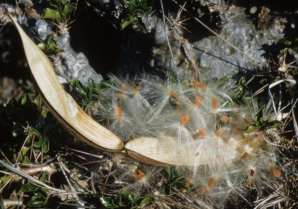
Conservation Status
Status
None of the species in the genus appear on the International Red List of the IUCN, but various species appear on regional and individual country Red Lists.
- In Namibia, P. namaquanum is listed as Low Risk but Near Threatened (LR-nt) and P. lealii as Low Risk Least Concerned (LR-lc
- In Zimbabwe P. saundersii is listed as Vulnerable. Pachypodium ambongense, P. baronii and P. decaryi are listed on CITES Appendix I and all other Pachypodium species on Appendix II.
- The habitats of pachypodiums in Madagascar are also disappearing fast as a result of human impact.
Urbanization and agriculture cause the decline of habitats and distribution range of many species, putting the smaller, slow-growing species especially at risk. Some authors argue that the mastering of propagation and cultivation would be the only means to ensure the long-term survival of many of these species.
The numbers of Pachypodium namaquanum have been reduced by the removal of smaller specimens by collectors, but fortunately only in the more accessible areas. The species is now heavily protected and not in immediate danger.
Distribution and habitat
Distribution description
The genus was established by Lindley in 1830, at the time on the basis of a single species. Today Pachypodium consists of about 20 species; five are native to continental Africa and the rest to Madagascar. In Africa they are found in arid areas or in dry situations in Angola, Namibia, Botswana, Zimbabwe, Swaziland, Mozambique and South Africa (Northern Province, Gauteng, Mpumalanga, Free State, KwaZulu-Natal and Northern, Western and Eastern Cape).
Derivation of name and historical aspects
History
The generic name is derived from the Greek word pachy which means thick, and podus, which means foot, and refers to the characteristic thickened or swollen base of the stems (these are often partially underground).
Ecology
Ecology
Pachypodiums are usually found in sunny positions in rocky environments where they are associated with other representatives of the flora of dry areas. They grow in frost-free situations; the exceptions being P. bispinosum and P. succulentum which can tolerate sub-zero temperatures in their natural environment in winter. They are found in xeric habitats and are naturally well-adapted to the hot and dry environment in which they grow. The succulent stems act as water stores and enable the plants to survive the harshest conditions. The thick tuberous underground stems also help the plants to survive long periods without water. All species can therefore withstand intense heat and long periods of drought.
In Madagascar, the species are found from sea level to about 1900 m, with temperatures ranging from 13°C to 40°C and the rainfall from 344-1985 mm per annum. The African species occur from sea level to about 1600 m, at temperatures from -10°C to 45°C and rainfall that varies from 75-800 mm a year.
The tufts of hairs on the seed indicate wind dispersal, but insects, birds and even small rodents may also aid in the dispersal. Seeds of Pachypodium namaquanum in the wild are heavily parasitized, possibly adding to the alleged rarity of the species.
Pachypodium densiflorum var. densiflorum is said to grow in association with sedges, which provide humus in the habitat on rocky sheets as the dead matter absorbs water. The pachypodiums become dry during the dry season but become spongy and then solid within a few days when they take up water. They can survive extreme temperatures.
Uses
Use
Not only the variation in form of the different species, but also the variations between specimens of the same species appeal to collectors. Most species are obtainable from specialist nurseries. Many nurseries sell some of the larger Madagascan species. Some species, for example Pachypodium lamerei, are even suitable as house plants as they can adapt to in-house conditions.
Pachypodium falls in a group of the Apocynaceae notorious for poisonous properties and for yielding potent poisons that have been used most effectively in arrow poison since ancient times. The active principles in these poisons are usually glucosides with a digitalis-like action that stimulates the heart, and their effect is well-known to hunters, who often control and administer them with great skill.
The smallest of all species is Pachypodium brevicaule in which the caudex is broader than tall and the spiny shoots are so compressed that only a tuft of spines surround each leaf rosette. It can be propagated from seed, but this takes a long time and it will almost always be a rarity.
The trunk of Pachypodium rutenbergianum is used as a source of fibre that can be woven into rope. The hollowed out trunks of P. geayi are used by some rural people as a primitive bee-hive. The gummy sap of various species is utilized in various ways. The sap of P. rosulatum is used as glue as well as a remedy for sores and boils. The pith from the centre of P. geayi is squeezed through a cloth to give a slimy, bitter, but drinkable sap. P. lealii provides an arrow poison and the tuberous root of P. bispinosum is used by local people of the Eastern Cape in brewing beer. The massive caudex of P. succulentum is reported to have native uses as food and as yeast for making bread. In times of shortage, the soft stems of P. geayi are mashed up to produce a sugary sap that is consumed as food.
All species are decorative, with striking flowers and boldly shaped stems, and make good subjects for rock gardens or containers in warmer climates. The bonsai appearance of young plants of Pachypodium bispinosum appeals to collectors. It has been horticulturally developed by many growers world-wide and many cultivars have been developed.
Growing Pachypodium
Grow
The attractive flowers of pachypodiums and the intriguing shapes of their swollen stems make them desirable for any garden. They are definitely not suitable for cold or damp gardens and are very sensitive to frost. If planted in a warm garden that experiences occasional frost they should be given a warm, sheltered position.
They make good accent plants in a rock garden, especially when grouped together with other caudiciform succulent plants such as species of Adenia, Adenium, Pelargonium, Cissus and Cotyledon. All need full sun, lots of water (except during the dormant phase) and must have good drainage.
Almost all species are surprisingly adaptable to cultivation, changing their growing season when they are grown in the northern hemisphere ( P. namaquanum is the only exception).
When re-potting or planting in the garden, care must be taken to avoid damage to the fleshy and brittle roots. Damaged roots or branches and discoloured tissue resulting from rot should be cut away cleanly with a sharp knife. After trimming, dust the severed ends with hormone rooting powder and set the plant in a dry, semi-shaded place to allow the wounds to heal. The plants like ample light and grow best in full sun. Partial shade is tolerated but may discourage flowering. When grown in a glasshouse, ventilation is important. Ample water is required during the growing season, depending on the species and the size of the specimen. The tall tree-like types such as P. lamerei and P. geayi need lots of water in the active growing season. Systemic fungicide could be added to the water for extra protection. Allow the soil to dry out before adding more water, then soak it thoroughly and never (even in winter) allow the soil to bake dry.
All species are sensitive to cold. The smaller species are suited to a warm glasshouse or sunny windowsill and can even be grown as a bonsai. Pachypodiums also make ideal container subjects. They are mainly cultivated from seed that germinate and establish easily.
PROPAGATION
Propagation is mainly from seed. Owing to CITES restrictions, mass exportation of plants from the wild is prohibited.
Seed
Seed is the only means by which plants reproduce in nature. Tape up the pair of horn-like pods when they turn pale brown with strips of masking tape or cotton yarn. This will prevent the fruit from splitting when mature and releasing the seed. Seeds soon lose their viability. Harvest fresh seed from the taped up pods and sow in a ± 5 mm deep, sterile, sandy medium (4 parts fine and 4 parts coarse river sand; 1 part sieved, well-rotten compost; 1 part perlite; 1 part vermiculite) in summer. Keep moist and at a temperature of 27°C to 35°C to ensure rapid germination. All seed not germinated after 6 weeks can be regarded as nonviable.
Stem Cuttings
Pachypodium bispinosum and P. succulentum are easily propagated from stem and root cuttings. Take 100-220 mm long cuttings from the youngest branches in late spring, seal the ends and dip in a rot-preventing mixture. Dust the ends with a rooting hormone powder and leave to dry out for about a week. Plant the cuttings in the same mixture as for seeds, but start watering only after root development. A warm environment, semishade and moisture will ensure that the cuttings root successfully.
Root Cuttings
Sections of the tap root of Pachypodium bispinosum and P. succulentum may produce the best results when making cuttings from roots. This can be done when plants in containers are re-potted.
Grafting
Any of the other pachypodiums can be grafted on Pachypodium lamerei, which is readily available. Especially the difficult-to-grow P. namaquanum is propagated this way. Most species (except P. succulentum ) show greatly accelerated growth as a result of grafting.
Species

Pachypodium baronii var. windsorii
Common names: none
The only red-flowered member of the genus. It is smaller than the typical variety and the peduncles are also much shorter. The spectacular red flowers with a white eye in the centre are ± 50 mm in diameter. The plant is found in northern Madagascar. It has all the makings of a good house plant, but unfortunately it is rare in the wild and known only from two populations. The globose or bottle-shaped base of the trunk reaches a diameter of 200 mm. The name commemorates Rev. R. Baron, a missionary in Madagascar from 1872-1907, who first collected this species. The name windsorii refers to Windsor Castle, one of the highest peaks in the northern part of Madagascar. This variety flowers from September to December. Plants grow on steep rocky gneiss slopes in full sun or in open dry forest in light shade. They flower profusely in spring.

Pachypodium bispinosum
Common names: bobbejaankos, kragman, sterkman, kamoa, kambroo (Afr.)
A succulent shrublet with a partially subterranean, tuberous stem up to 0.6 m tall, the branches armed with paired straight spines 10-20 mm long. The narrow leaves are scattered or in tufts on the stems. The broad, bell-shaped flowers are few and in clusters at the tips of the branches, 15-20 mm in diameter. Flowers appear with the leaves from August to December in shades of purple to pink. It is the most floriferous of all species in cultivation. The species is a lmost entirely confined to the Eastern Cape Province in South Africa where it occurs on stony places in dry succulent scrub in dry rocky situations. The name is of no special significance as all pachypodiums possess paired spines. When not in flower it is indistinguishable from P. succulentum with which it overlaps in distribution. P. succulentum has thick, bonsai-like branches and the leaves are less hairy with margins curling down more distinctly and spines that are shorter.
Pachypodium densiflorum var. densiflorum
Common names: none
A succulent shrublet with a swollen stem that can attain a diameter of up to 2 m and a height of ± 0.7 m. It carries many short and upright, spiny branches. The flowers are yellow or sometimes tinted deep yellow and orange and appear in spring. The leaves are elliptic, dark green above and paler below. The plants grow in southern, central and northern Madagascar on granite outcrops at altitudes of ± 1 500 m. This variety is distinguished from var. brevicalyx by the shorter calyx of the latter. The corolla opens out almost flat, with a saucer-like depression in the centre in a deeper yellow than in P. rosulatum.
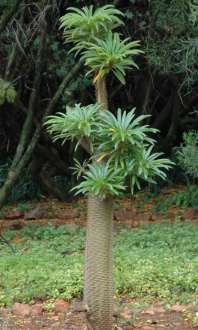
Pachypodium geayi
Common names: none
A tree of up to 8 m with a thick trunk that branches from a height of ± 3 m or more. Compared to P. lamerei, it has longer and thinner leaves at the tips of branches and the leaves and spines are covered in a velvet-grey hairiness. The white flowers are borne on much-branched inflorescences. The plants grow in dry woodland on calcareous and schist soils. It is more local and narrower in tolerance than P. lamerei, and in cultivation it seems to be more delicate. The epithet commemorates M. Geay who discovered the species. It grows in sand in low dry forest at altitudes from 0-100 m.
Pachypodium horombense
Common names: none
A succulent shrublet ± 1.5 m high with a swollen tuberous main stem and a number of short, spiny branches each bearing a rosette of leaves. They have a single long-pedunculate inflorescence that carries 3-10, broadly cup-shaped, chrome-yellow flowers between April and August. The flower has an inflated corolla that forms five large sacs into which the pollinator can crawl. The epithet refers to the Horombe plateau in southern Madagascar where the type specimen comes from. Here it grows on granite rocks at altitudes of 500-1 000 m. It is impossible to distinguish it from P. rosulatum when not in flower.
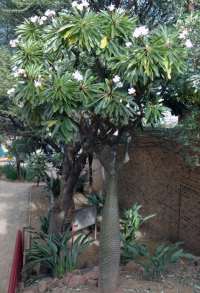
Pachypodium lamerei
Common names: none
A succulent, arborescent species but is very variable. Plants are 1.5-8.0 m high, with a sturdy, branched stem. The tips are clogged in a dense mass of branches with dark olive-green leaves that are glossy above and paler below. The flowers are large and white. This species is found in southern and south-western Madagascar. It commemorates Lamère, whose collections included the type specimen. It grows on limestone or gneiss rocks in dry forest or in full sun up to 750 m above sea level.
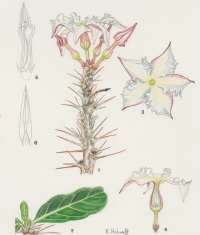
Pachypodium lealii
Common names: bottle tree (Eng.); bottelboom (Afr.)
A shrub or tree up to 8 m tall with a soft, succulent, bottle-shaped trunk, wide at the bottom, becoming narrower higher up and forked at the tips. The few leaves on the tips of the branchlets are narrowly oblong to egg-shaped and velvety. The plants grow on arid to semi-arid, rocky hillsides in north-western Namibia and south-western Angola. The long, pointed buds open into large frilly, white, sweet-smelling flowers, the underside of the petals and tube flushed with purple. Flowering time is from about July to September, before the leaves appear. The species is closely related to P. saundersii, but the two are separated by more than 1 000 km. The difference in pubescence of the leaves and the striking difference in habit are the only means to separate them. The epithet commemorates Fernando Da Costa Leal, an officer in the Portuguese Army and administrator of the province of Huila, who assisted Welwitsch during his travels in southern Angola.
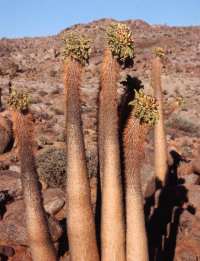
Pachypodium namaquanum
Common names: elephant's trunk (Eng.); halfmens (Afr.)
A succulent with a cylindrical, spiny and unusually branched stem up to 1.5 m high. The tips of the branches are crowned with rosettes of grey-green velvety leaves with crisped margins. Flowers appear from August to October. These are long, tubular, yellowish on the outside, wine-red inside and nested inside the head of leaves which later dry out and drop off during the hot summer. The halfmens inhabits extremely dry, rocky slopes in northern Namaqualand (Northern Cape in South Africa ) and southern Namibia with the roots wedged between large boulders and in rock crevices.
Pachypodium rosulatum
Common names: none
A succulent, dwarf shrub. Mature plants are irregularly lobed with short, thick, tapered branches dividing again near the tips to form a coral-like crown usually shorter than 1 m, but wider than 2 m. The base becomes smooth and the upper half remains covered with sharp but weak conical spines. The sessile leaves are pubescent and paler green below. The name means rosetted, presumably referring to the tufts of leaves. It is the most widespread species in Madagascar where it is found along almost the entire length of the island. It grows in full sun in pockets of humus or in rock crevices and the yellow flowers are borne in spring. Flowering terminates the longitudinal growth, causing the plant to branch after each flowering event.
Pachypodium saundersii
Common names: kudu lily, impala lily, rathbonia (Eng.); koedoelelie, impalalelie (Afr.); ligubugubu, sikymbyambya, sisila-semphala (siSwati), insema-yamatshe, isihlehle (isiZulu), Lundi star (Zimbabwe)
A succulent shrub with a large stem up to 1.5 m high. The exposed tuberous stem is up to 1 m in diameter and produces several narrow, thorny branches. The flowers are white, wax-like, tinged purplish pink and are borne from February to May. The glossy leaves are almost glabrous. It naturally occurs from northern KwaZulu-Natal and the Lebombo Range into Mpumalanga and Limpopo Provinces (South Africa) to Swaziland, southern Mozambique and Zimbabwe. This species grows in dry woodland amongst rocks or in rock crevices. The epithet honours Sir Charles James Renault Saunders.
Pachypodium succulentum
Common names: dikvoet, ystervarkkambroo, bergkambroo, bobbejaankambroo, bobbejaankos (Afr.)
A a succulent shrublet with a partially underground tuberous stem and is up to 0.6 m tall. The narrow leaves are in tufts. Flowers consist of a narrow tube with flat, expanded corolla lobes. A few are carried at the tips of branches in pink to crimson colours, usually with darker stripes, rarely white. The flowers appear with the leaves, from September to December. This plant grows in arid, stony places, in dry scrub and is w idely distributed in the Western, Eastern and Northern Cape Provinces and western Free State (South Africa). There is considerable variation in corolla size and colour and it has been described under several different names. P griquense is merely a small-flowered form and P. jasminiflorum is a white-flowered form. The epithet means succulent.
References
- Codd, L.E. 1963. Apocynaceae. Flora of southern Africa 26. Botanical Research Institute, Pretoria.
- Codd, L.E. 1985. Pachypodium baronii var. windsorii. The Flowering Plants of Africa 48: t. 1916.
- Codd, L.E. 1987. Pachypodium lealii. The Flowering Plants of Africa 49: t. 1959.
- Coetzee, J.A. 1959. Pachypodium succulentum. The Flowering Plants of Africa 33: t. 1306.
- Court, D. 2000. Succulent flora of southern Africa, revised edn. Balkema, Rotterdam.
- Dyer, R.A. 1940. Pachypodium namaquanum. The Flowering Plants of South Africa 20: t. 771.
- Germishuizen, G. & Fabian, A. 1997. Wildflowers of northern South Africa. Fernwood Press, Vlaeberg, Cape Town.
- Golding, J. (ed.). 2002. Southern African plant Red Data Lists. Southern African Botanical Diversity Network Report No. 14. SABONET, Pretoria.
- Killick, D.J.B. 1990. Pachypodium horombense. The Flowering Plants of Africa 51: t. 2001.
- Killick, D.J.B. 1990. Pachypodium densiflorum var. densiflorum. The Flowering Plants of Africa 51: t. 2002.
- Leistner, O.A. (ed.). 2000. Seeds plants of southern Africa : families and genera. Strelitzia 10. National Botanical Institute, Pretoria.
- Manning, J., Batten, A. & Bokelmann, H. 2001. Eastern Cape. South African Wildflower Guide 11. Botanical Society of South Africa, Cape Town.
- Oliver, I.B. 1998. Grow succulents. Kirstenbosch Gardening Series. National Botanical Institute, Cape Town.
- Onderstall, J. 1984. Transvaal lowveld and escarpment including the Kruger National Park. South African Wild Flower Guide 4. Botanical Society of South Africa, Cape Town.
- Palmer, E. & Pitman, N. 1972. Trees of southern Africa, vols 1 & 3. Struik, Cape Town.
- Pole Evans, I.B. 1921. Pachypodium succulentum. The Flowering Plants of South Africa 1: t. 21.
- Pole Evans, I.B. 1924. Pachypodium saundersii. The Flowering Plants of South Africa 4: t. 123.
- Pooley, E. 1998. A field guide to wild flowers of KwaZulu-Natal and the Eastern Region. Natal Flora Publications Trust, Durban.
- Rapanarivo, S.H.J.V., Lavranos, J.J., Leeuwenberg, A.J.M. & Röösli, W. 1999. Pachypodium (Apocynaceae) taxonomy, habitats and cultivation. Balkema, Rotterdam.
- Rowley, G.D. 1983. The Adenium and Pachypodium handbook. British Cactus and Succulent Society, Oxford.
- Rowley, G.D. 1987. Caudiciform and pachycaul succulents. Pachycauls, bottle-, barrel-, and elephant-trees and their kin: a collector's miscellany. Strawberry Press, California, USA.
- Rowley, G.D. 1999. The Cactus File Handbook 5: Pachypodium and Adenium. Nuffield Press, Oxford.
- Smith, C.A. 1966. Common names of South African plants. Memoirs of the Botanical Survey of South Africa No. 35.
- Van Wyk, B.-E., Van Heerden, F. & Van Oudtshoorn, B. 2002. Poisonous plants of South Africa. Briza Publications, Pretoria.
- Vorster, P. 1978. Pachypodium rosulatum. The Flowering Plants of Africa 45: t. 1770.
Credits
Stoffel Petrus Bester
National Herbarium, Pretoria
December 2007
Plant Attributes:
Plant Type: Shrub, Succulent, Tree
SA Distribution:
Soil type:
Flowering season:
PH:
Flower colour:
Aspect:
Gardening skill:
Special Features:
Horticultural zones







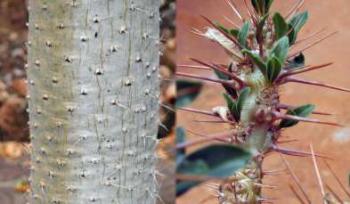
Rate this article
Article well written and informative
Rate this plant
Is this an interesting plant?
User Comments
Jill Kramer, United States
April 21, 2016 at 5:05 PMHello there! I have had a Pachypodium geayi for about 10 years and it has gotten quite large - at least 10 feet! We love this plant and don't want to lose it, but after this summer out I'm not sure we can fit it in our house! It seems to love being outside for the summer - grows about a foot each year! My question is, can I lop the top off and perhaps it will survive? This has no branches, unlike my Pachypodium lamereii which has branched heavily - so I am concerned if I cut the top off it'll die. Any advice? Love your website - very informative and well done. Thanks so much! Jill Kramer
Alice Notten
June 09, 2016 at 2:09 PMHello Jill
You can cut the top off, but dust the wound with sulphur powder to prevent rotting. It should resprout again.
Also, treat the cut part as a stem cutting and see if you can get it to root.
Login to add your Comment
Back to topNot registered yet? Click here to register.